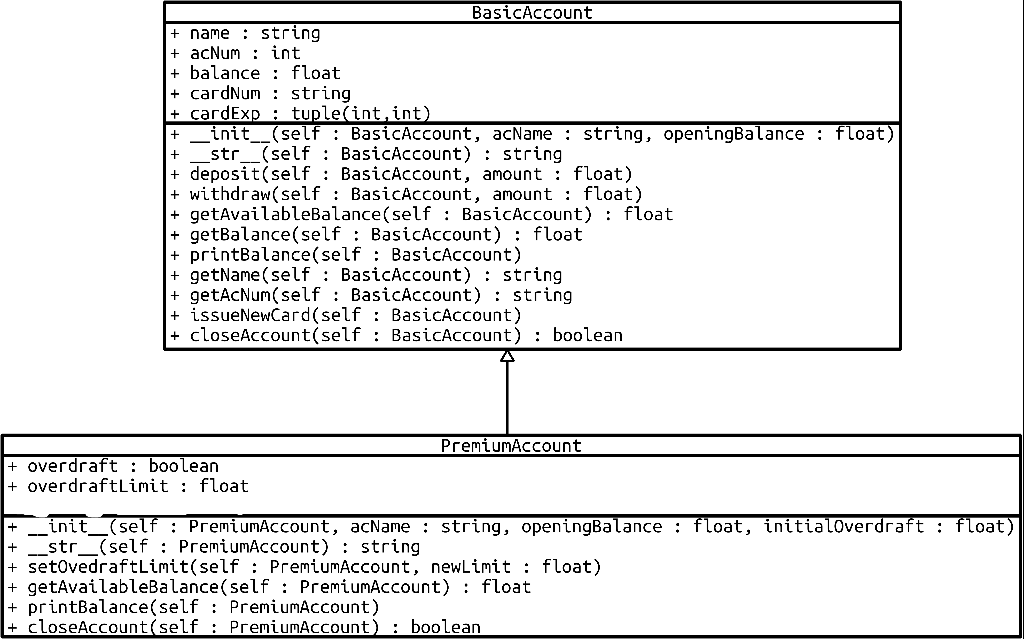Question
Please do not post the same code as currently on chegg ty Phython only implement two classes in Python: B asicAccount and P remiumAccount. The
Please do not post the same code as currently on chegg ty
Phython only
implement two classes in Python: BasicAccount and PremiumAccount.
The classes are to be adherent to the following UML Class diagram, though you may add extra methods and variables if you wish (essentially, the class diagram is a minimum, and it shows you what will be tested against):
To read the UML diagram, a line of
A line of
The variables of the classes are described as follows:
-
name the account holders name
-
acNum the number of the account. This should be serial, as in the first account to be created should be number 1, the second account to be created should be 2, and so on...
-
balance The balance (in pounds) of the account.
-
CardNum The card number should be a string of a 16 digit number (you should use the random module for this)
-
cardExp - a tuple where the first element is an int of the month and the second element is 2-digit year. Eg: 03/23 represents March 2023 (You should use the datetime module for this)
-
overdraft True if the account has an overdraft, and false if not
-
overdraftLimit The amount that the account can go overdrawn by
The method behaviours are as follows:
-
__init__(self, str, float)
Initialiser giving the account name and opening balance
-
__init__(self, str, float, float) initialiser giving the account name, opening balance, and overdraft limit (0 or above)
-
deposit(self, float) Deposits the stated amount into the account, and adjusts the balance appropriately. Deposits must be a positive amount.
-
withdraw(self, float) Withdraws the stated amount from the account, prints a message of
has withdrew . New balance is . If an invalid amount is requested, then the following message should be printed, and the method should then terminate: Can not withdraw -
getAvailableBalance(self) Returns the total balance that is available in the account as a float. It should also take into account any overdraft that is available.
-
getBalance(self) returns the balance of the account as a float. If the account is overdrawn, then it should return a negative value.
- printBalance(self) Should print to screen in a sensible way the balance of the account. If an overdraft is available, then this should also be printed and it should show how much overdraft is remaining.
-
getName(self) Returns the name of the account holder as a string
-
getAcNum(self) Returns the account number as a string
-
issueNewCard(self) Creates a new card number, with the expiry being 3 years to the month from now. (eg: if today is 3/12/20, then the expiry date would be (12/23))
-
closeAccount(self) To be called before deleting of the object instance. Returns any balance to the customer (via the withdraw method) and returns True. Returns False if the customer is in debt to the bank, and prints message Can not close account due to customer being overdrawn by
Clarification: You shouldnt actually delete the account instance.... this function will simply do the relevant house keeping in the account, and return a boolean -
setOverdraftLimit(self, float) Sets the overdraft limit to the stated amount
In addition to the above, you must also define suitable string representations that give the account name, available balance, and overdraft details (that is: you need to also implement the __str__ methods for each class).

Step by Step Solution
There are 3 Steps involved in it
Step: 1

Get Instant Access to Expert-Tailored Solutions
See step-by-step solutions with expert insights and AI powered tools for academic success
Step: 2

Step: 3

Ace Your Homework with AI
Get the answers you need in no time with our AI-driven, step-by-step assistance
Get Started


